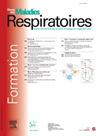IL-1β contribute to NGF-induced alterations in pulmonary hypertension
IF 0.5
4区 医学
Q4 RESPIRATORY SYSTEM
引用次数: 0
Abstract
Introduction
Pulmonary Hypertension (PH) is a severe disease leading to right heart failure and death. We have previously demonstrated a pathological role of the nerve growth factor NGF in PH, particularly in pulmonary arterial inflammation. We have here studied the link between NGF, monocytes/macrophages and interleukin-1β (IL-1β), a pro-inflammatory cytokine secreted in response to NGF and overexpressed in PH.
Methods
In vivo, PH was induced in rats by monocrotaline (60 mg/kg, intraperitoneal (ip) injection) in the absence or presence of a preventive treatment with anti-NGF blocking antibodies (10 μg/kg, ip injection). IL-1β pulmonary levels were then determined (ELISA). Expression of inflammasome components (NLRP3/pro-caspase-1/ASC/caspase-1/pro-IL-1β), of NGF and of monocytes/macrophages markers (CD11b/CD68) was evaluated by Western blotting (WB) in lung homogenates. Expression of CD68was also evaluated by immunohistochemistry in pulmonary arteries.
In vitro, both on the monocytic cell line THP-1 and on freshly isolated human monocytes, cell migration (Transwell assay) and/or proliferation (counting) were studied in response to NGF. Control human pulmonary arterial smooth muscle (hPASMC) or endothelial cells (hPAEC) were treated with IL-1β, and cell proliferation (counting), migration (Transwell assay), and interleukin-6 (IL-6) secretion (ELISA) were then assessed. In hPAEC, expression of endothelial nitric oxide synthase (eNOS), intercellular adhesion molecule-1 (ICAM-1), CD31, VE-cadherin, Snail and Twist 1 was also assessed (WB).
Results
In vivo, IL-1β pulmonary levels were increased in PH rats, as observed in PH patients. Expression of inflammasome components such as procaspase-1, ASC, caspase-1 and pro-IL-1β was significantly increased in lung homogenates from PH rats compared to controls. CD68expression was also significantly increased in both the lung and pulmonary arteries (PA) from PH rats compared to controls. Treatment with anti-NGF antibodies prevented PH development and reduced expression of inflammasome proteins and of CD68in both the lung and PA. In vitro, NGF induced migration and/or proliferation of both THP-1 cells and freshly isolated human monocytes. In hPASMC and hPAEC, IL-1β significantly increased cell proliferation, migration and IL-6 secretion in a NF-kB and/or AP-1-dependent manner, with IL-6 secretion induced by IL-1β playing a role in IL-1β-dependent cell proliferation and migration. In hPAEC, IL-1β also significantly increased ICAM-1 and Snail expression and significantly decreased eNOS, CD31and VE-cadherin expression, mechanisms known to contribute to endothelial dysfunction and loss of endothelial phenotype in PH.
Conclusion
Our results suggest that NGF can trigger monocytes/macrophages migration into the lung and PA, thus contributing to an inflammatory environment in particular by release of IL-1β. These mechanisms may then participate in PA dysfunction in PH by stimulating both hPASMC and hPAEC to induce remodelling, inflammation pathways and altered endothelial function. Since NGF contributes to IL-1β increased levels in PH, IL-1β may therefore contribute to NGF-dependent PA alterations in this disease.
IL-1β参与ngf诱导的肺动脉高压改变
肺动脉高压(PH)是一种严重的疾病,可导致右心衰和死亡。我们之前已经证明了神经生长因子NGF在PH中的病理作用,特别是在肺动脉炎症中。我们研究了NGF、单核/巨噬细胞和白细胞介素-1β (IL-1β)之间的联系,白细胞介素-1β是一种在NGF反应下分泌并在PH中过表达的促炎细胞因子。方法在体内,在没有或存在抗NGF阻断抗体(10 μg/kg, ip注射)的情况下,用单根碱(60 mg/kg,腹腔注射)诱导大鼠PH。ELISA法检测肺组织IL-1β水平。Western blotting (WB)检测肺匀浆中炎性小体成分(NLRP3/pro-caspase-1/ASC/caspase-1/pro-IL-1β)、NGF和单核/巨噬细胞标志物(CD11b/CD68)的表达。免疫组化法检测肺动脉组织中cd68的表达。在体外,在单核细胞系THP-1和新分离的人单核细胞上,研究了NGF对细胞迁移(Transwell实验)和/或增殖(计数)的反应。对照组人肺动脉平滑肌(hPASMC)或内皮细胞(hPAEC)用IL-1β处理,然后评估细胞增殖(计数)、迁移(Transwell实验)和白细胞介素6 (IL-6)分泌(ELISA)。在hPAEC中,内皮一氧化氮合酶(eNOS)、细胞间粘附分子-1 (ICAM-1)、CD31、VE-cadherin、Snail和Twist 1的表达也被评估(WB)。结果PH大鼠肺内IL-1β水平升高,PH患者肺内IL-1β水平升高。与对照组相比,PH大鼠肺匀浆中炎性小体成分如procaspase-1、ASC、caspase-1和pro-IL-1β的表达显著增加。与对照组相比,PH大鼠肺和肺动脉(PA)中的cd68表达也显著增加。用抗ngf抗体治疗可阻止PH的发展,并降低肺和PA中炎性体蛋白和cd68的表达。在体外,NGF诱导THP-1细胞和新分离的人单核细胞的迁移和/或增殖。在hPASMC和hPAEC中,IL-1β以NF-kB和/或ap -1依赖的方式显著增加细胞增殖、迁移和IL-6分泌,IL-1β诱导的IL-6分泌在IL-1β依赖的细胞增殖和迁移中发挥作用。在hPAEC中,IL-1β也显著增加了ICAM-1和Snail的表达,并显著降低了eNOS、cd31和VE-cadherin的表达,这是已知的导致ph内皮功能障碍和内皮表型丧失的机制。我们的研究结果表明,NGF可以触发单核/巨噬细胞向肺和PA迁移,从而通过释放IL-1β来促进炎症环境。这些机制可能通过刺激hPASMC和hPAEC诱导重塑、炎症通路和内皮功能改变而参与PH中PA功能障碍。由于NGF导致PH中IL-1β水平升高,因此IL-1β可能导致该疾病中NGF依赖性PA的改变。
本文章由计算机程序翻译,如有差异,请以英文原文为准。
求助全文
约1分钟内获得全文
求助全文
来源期刊

Revue des maladies respiratoires
医学-呼吸系统
CiteScore
1.10
自引率
16.70%
发文量
168
审稿时长
4-8 weeks
期刊介绍:
La Revue des Maladies Respiratoires est l''organe officiel d''expression scientifique de la Société de Pneumologie de Langue Française (SPLF). Il s''agit d''un média professionnel francophone, à vocation internationale et accessible ici.
La Revue des Maladies Respiratoires est un outil de formation professionnelle post-universitaire pour l''ensemble de la communauté pneumologique francophone. Elle publie sur son site différentes variétés d''articles scientifiques concernant la Pneumologie :
- Editoriaux,
- Articles originaux,
- Revues générales,
- Articles de synthèses,
- Recommandations d''experts et textes de consensus,
- Séries thématiques,
- Cas cliniques,
- Articles « images et diagnostics »,
- Fiches techniques,
- Lettres à la rédaction.
 求助内容:
求助内容: 应助结果提醒方式:
应助结果提醒方式:


